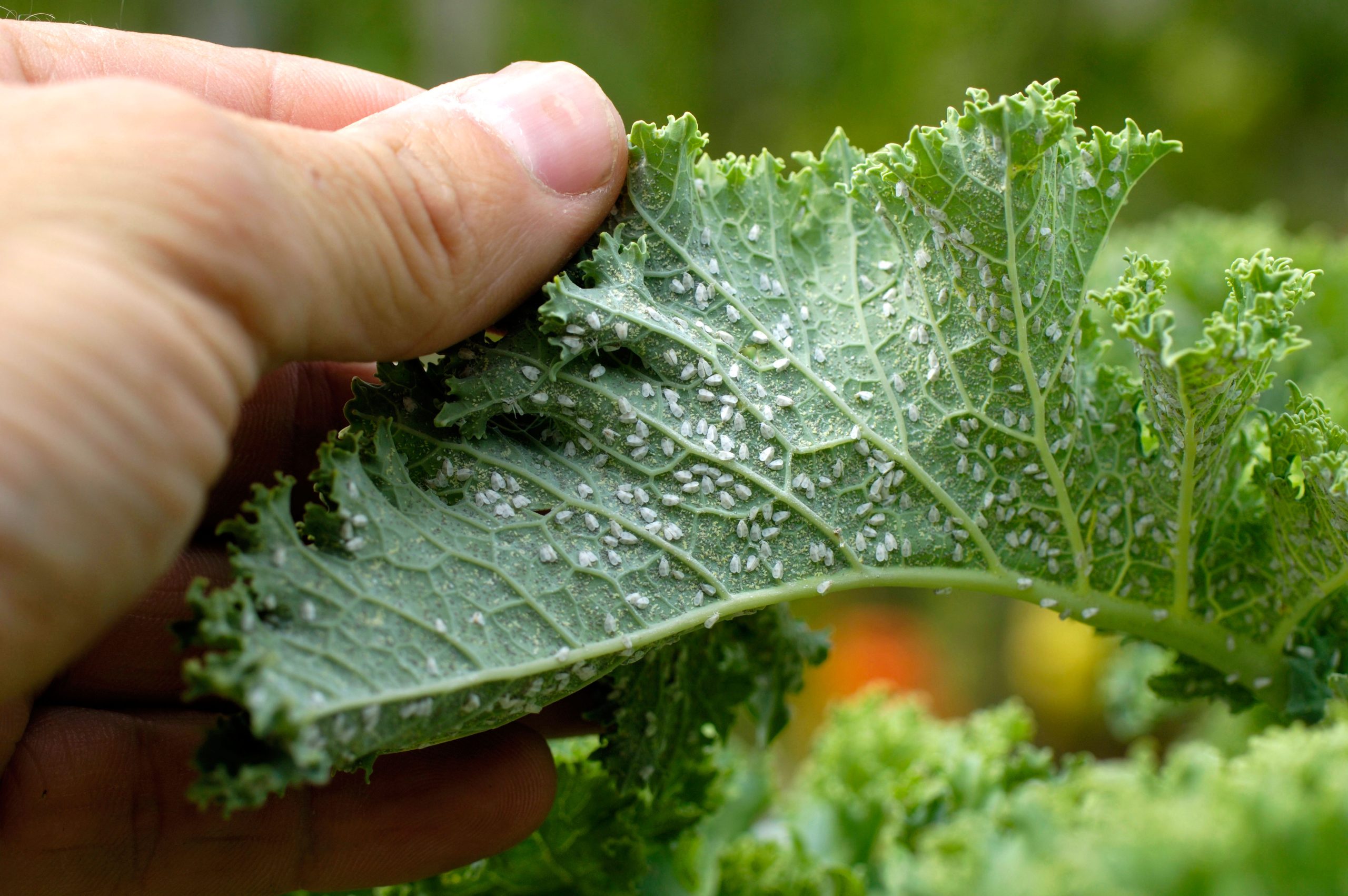Our world, particularly North America, is home to myriad insects that sport a green hue. Many of these are capable of flight, while others are adept crawlers.
Certain green insects, like grasshoppers, possess the remarkable ability to leap.
Evolution has equipped these bugs with a green exterior for camouflage, a survival tactic that allows them to blend effortlessly into the leafy habitats where they reside or feed.
It’s fascinating that a bug’s life can commence as a nymph of a different color, only to transform into a green adult insect later.
Interestingly, while some species are uniformly green, others display a beautiful blend of various shades.
Let’s take a look at some common examples of insects that are either entirely or predominantly green in color.
1. Green Lacewings
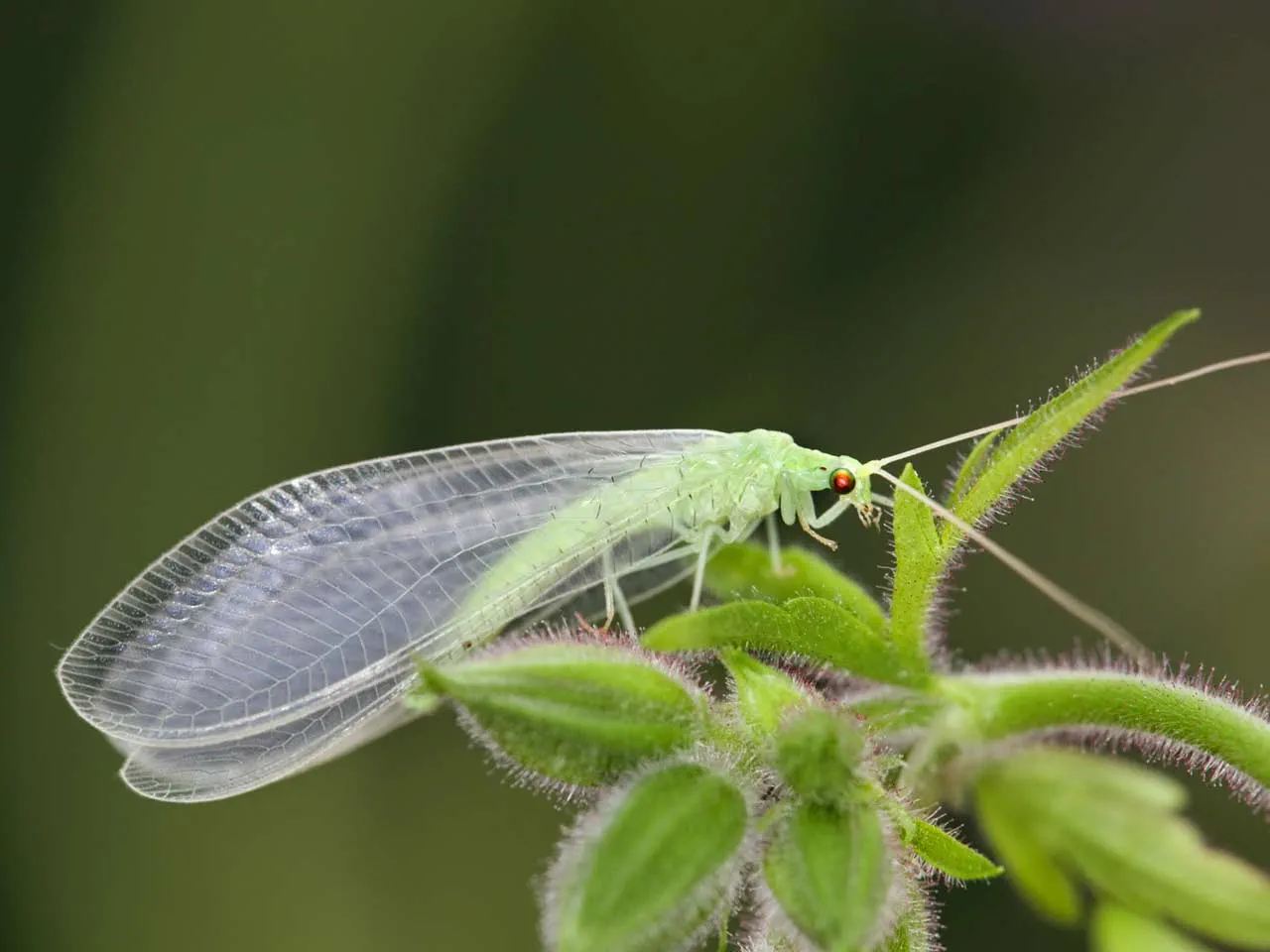
The Green Lacewings, belonging to the Chrysopidae family, are a prevalent green insect found in North America, often growing to achieve a wingspan up to 60mm.
Although the North American Green Lacewings aren’t as big as their tropical counterparts, they can still seem larger when compared to other insects.
These insects are distinct for their green body color, ranging from a deep, vibrant green to a lighter, yellowish-green hue.
Many species feature captivating large golden eyes, although some can be a shade closer to brown.
Another characteristic trait of Green Lacewings is their translucent and slightly shimmering wings, adorned with distinct veins. These veins often mirror the insect’s green color, but sometimes they may showcase a mix of green and black.
2. Banana Cockroaches
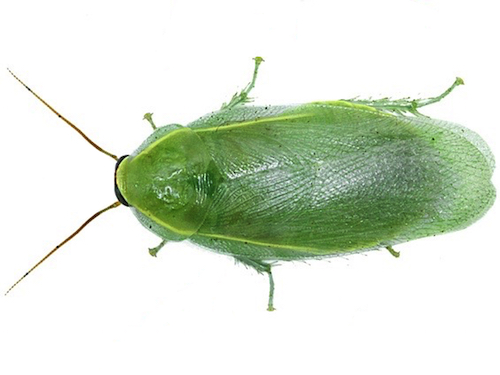
The Banana Cockroaches, known scientifically as Panchlora nivea, are consistently found throughout the southern regions of the United States.
Originally from tropical environments, these roaches have migrated northward, extending their presence as far as South Carolina.
These roaches are particularly distinctive due to their unconventional green hue, often displaying shades of lime or bright green.
However, it’s interesting to note that young Banana Cockroaches do not start life green. They initially showcase a dark brown shade and transition to green as they age.
Uncommonly found within homes, these roaches are more likely to be spotted near fresh or decaying fruit in gardens or rummaging through dead plant matter.
These insects from the Panchlora genus are infrequently classified as pests since they generally favor outdoor habitats.
3. Tree Crickets

The Tree Crickets, belonging to the Oecanthinae subfamily, prominently feature a verdant green color throughout their body.
Being creatures of the night, they employ their green hue as a camouflage tactic, allowing them to blend seamlessly into the foliage of various plants while they rest.
Both the forewings and hindwings of these crickets mirror the green of their body. This coloration extends to their slender legs, while their antennae may also exhibit hints of green.
The cricket’s eyes usually also possess a touch of green or yellow.
Although found across all habitats in North America, a handful of Tree Cricket subspecies may bear a brown hue.
One of the quintessential examples of green Tree Crickets is the Snowy Tree Cricket. This species is almost completely green and typically measures around 0.6 inches in size.
4. Pure Green Sweat Bee
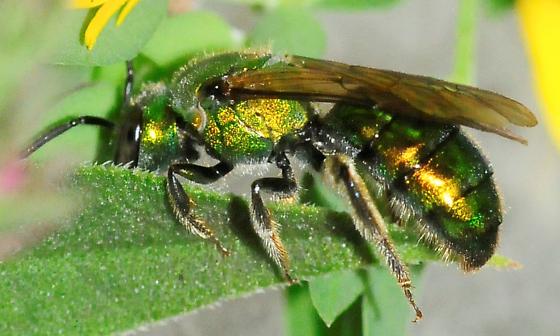
Exhibiting a predominant green hue, the Pure Green Sweat Bee, scientifically known as Augochlora pura, is truly distinct.
This bee species is native to the eastern regions of North America and is primarily active during the summer months.
Their unique color scheme comprises a green body and dark legs adorned with white hairs. These bees also feature large black eyes and translucent wings with a smoky tinge.
Typically, they can be observed until August each year. As autumn sets in, female bees retreat into dead wood or seek shelter under tree bark.
Interestingly, male Pure Green Sweat Bees have a shorter lifespan, dying off in the fall. They only make a comeback in the spring and early summer of the following year.
5. Brown-Winged Striped Sweat Bee

The bee species Agapostemon splendens, although primarily green, boasts a more expansive range across the United States compared to the Pure Green Sweat Bees.
Their habitat stretches from Montana to Texas, indicating the northernmost and southernmost points of their distribution.
The sightings of this species vary throughout the year, depending on the geographical region they inhabit.
Known as the Brown-winged Striped Sweat Bees, these insects display a dominant green color.
Their abdomen stands out with white or yellow stripes, while their legs and antennae are predominantly black.
The eyes of this species come in a variety of colors, including yellow, a combination of yellow and black, off-white, or even silver.
As for their wings, they exhibit a smoky brown hue and a slight translucence, lending the species its distinctive name.
6. Texas Striped Sweat Bee
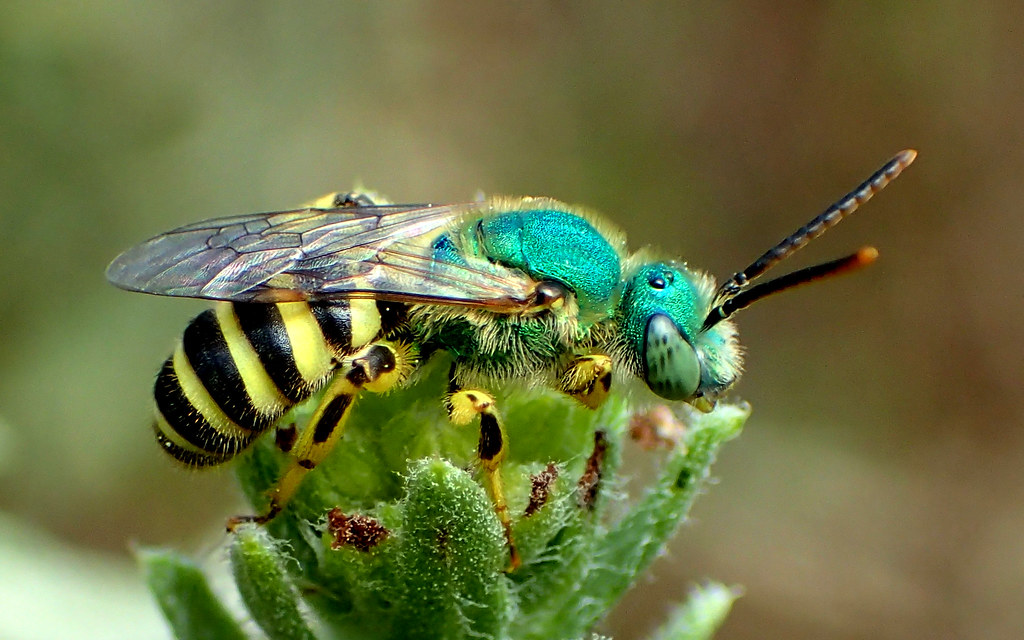
The Texas Striped Sweat Bees, or Agapostemon texanus, are originally from the southern regions of the United States, but their reach has extended to various parts of North and Central America.
Both the male and female bees of this species feature a predominantly green thorax, with the males also showcasing yellow and black stripes on their abdomen.
The bees grow up to 11mm in length, with the females generally being slightly larger than their male counterparts.
These bees are known for their unique nesting behavior. Preferring to live underground, the female bees construct extensive nests, often comprising more than 10 tunnels or chambers.
During the summer, these bees are frequently observed frequenting flowers. Remarkably, they can visit dozens of flowers within an hour, strategically moving farther from their nest with each flower they visit in a calculated approach to gather pollen.
7. Metallic Bluish-Green Cuckoo Wasp
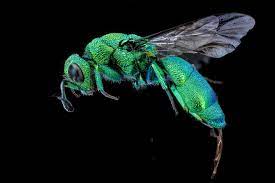
The Chrysis angolensis, a species of wasp, is frequently observed in North America.
Though not extensively researched, these wasps are primarily seen along the East and West Coasts, while also inhabiting regions further inland.
This species feeds on both larvae and adult mud daubers. Each of their eggs, which are sealed in an underground nest by the female, is provided with a bug.
True to its name, this wasp exhibits a green hue with a distinct metallic undertone that appears more vibrant under direct sunlight.
Despite having lengthy ovipositors, the female wasps are incapable of stinging.
One way to distinguish Metallic Bluish-green Cuckoo Wasps from other species is their reaction to humans or animals. Upon sensing a threat, these wasps tend to curl up into a ball and either remain still or reduce their movement until the perceived danger has passed.
8. Emerald Cockroach Wasp
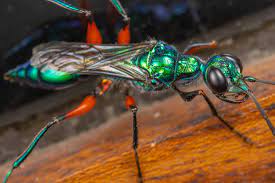
Present in select regions around the globe, this wasp species, originally from Asia, is characterized by its emerald green coloration complemented by red and black segments.
Belonging to a venomous family, these wasps are known to bite, although their sting is usually reserved for their primary prey – cockroaches, which they feed to their nymphs.
Emerald Cockroach Wasps, or Ampulex compressa, have the ability to paralyze various cockroach species by injecting their venom.
In an even more peculiar behavior, these wasps consume the antennae of the cockroach, depriving it of movement. The immobilized cockroach is then transported back to the wasp’s nest, where it serves as food for the emerging nymph.
9. Six-Spotted Tiger Beetle
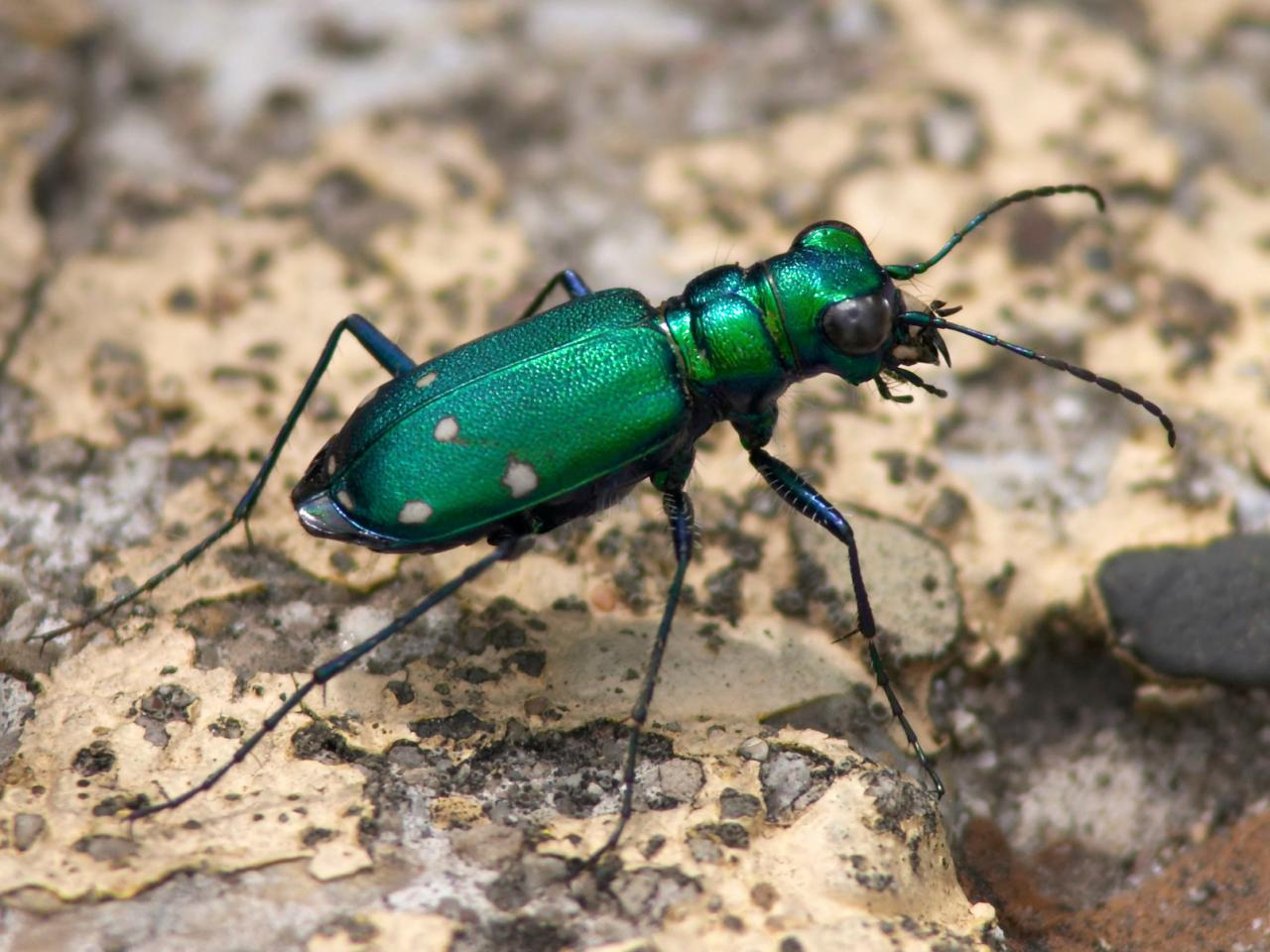
The Six-spotted Tiger Beetle, or Cicindela sexguttata, earned its name from the six white dots adorning its elytra, although some individuals of this species may feature more or fewer spots.
Interestingly, it’s not a rare sight to see this beetle displaying an entirely green elytra with distinct spots.
This species is characterized by a green color with a metallic sheen, and their overlapping mandibles serve as a distinguishing trait from other forest beetles.
Residing primarily in woodlands, these beetles coexist with a multitude of spiders.
They primarily feed on a variety of arthropods and are also known to bite humans, which while not overly painful, can occur when the beetle is handled.
Sandy woodland areas are common habitats for these tiger beetles and are also important for their mating rituals. Upon emerging, the nymphs burrow into the sand, marking the beginning of their life cycle.
10. Common Green June Beetle

The beetle species Cotinis nitida has a broad distribution across North America and is easily recognizable due to its unique green coloration.
Predominantly, the mid-dorsal section of this beetle boasts a vibrant green, while its sides exhibit a golden hue or a transition from gold to brown.
The beetle’s head also carries the green hue, but its legs present a more brown or golden color.
Aging in this species is accompanied by a distinct darkening of color. The beetles, initially bright green, gradually transform to a darker green hue as they age.
Despite being a pest, the Common Green June beetle’s green color plays to its advantage.
Frequently found on fruit trees, its green and golden coloration allows it to blend in with its surroundings.
Regrettably, this species poses a threat to fruits like pear and apple, as it tends to consume them before they are harvested.
11. Dogbane Leaf Beetle
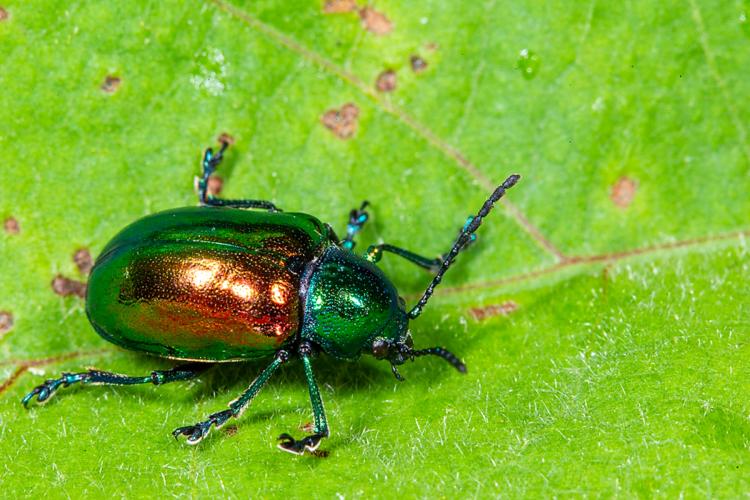
The Dogbane Leaf Beetle, known scientifically as Chrysochus auratus, is one of the rare species that feeds exclusively on the toxic plant known as dogbane.
This plant is inedible for both humans and animals due to its toxic compounds which can potentially lead to cardiac arrest.
Remarkably, the Dogbane Leaf Beetle can consume the plant without any adverse reactions to its toxins.
The beetle is characterized by an elytra with a predominantly metallic green color.
Its elytra also features a distinguishable brown section adorned with golden margins.
The beetle’s legs present a half green and half black coloration, while its antennae are entirely black.
In terms of size, it’s comparable to other plant-eating beetles. While it can grow up to 11mm in length, the average size of individuals is typically around 8-9mm.
The lifecycle of this species is deeply intertwined with dogbane. After mating, female beetles lay their eggs on the underside of dogbane leaves.
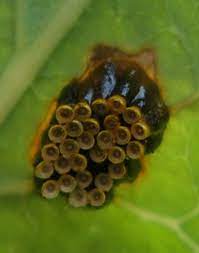
12. Figeater Beetle
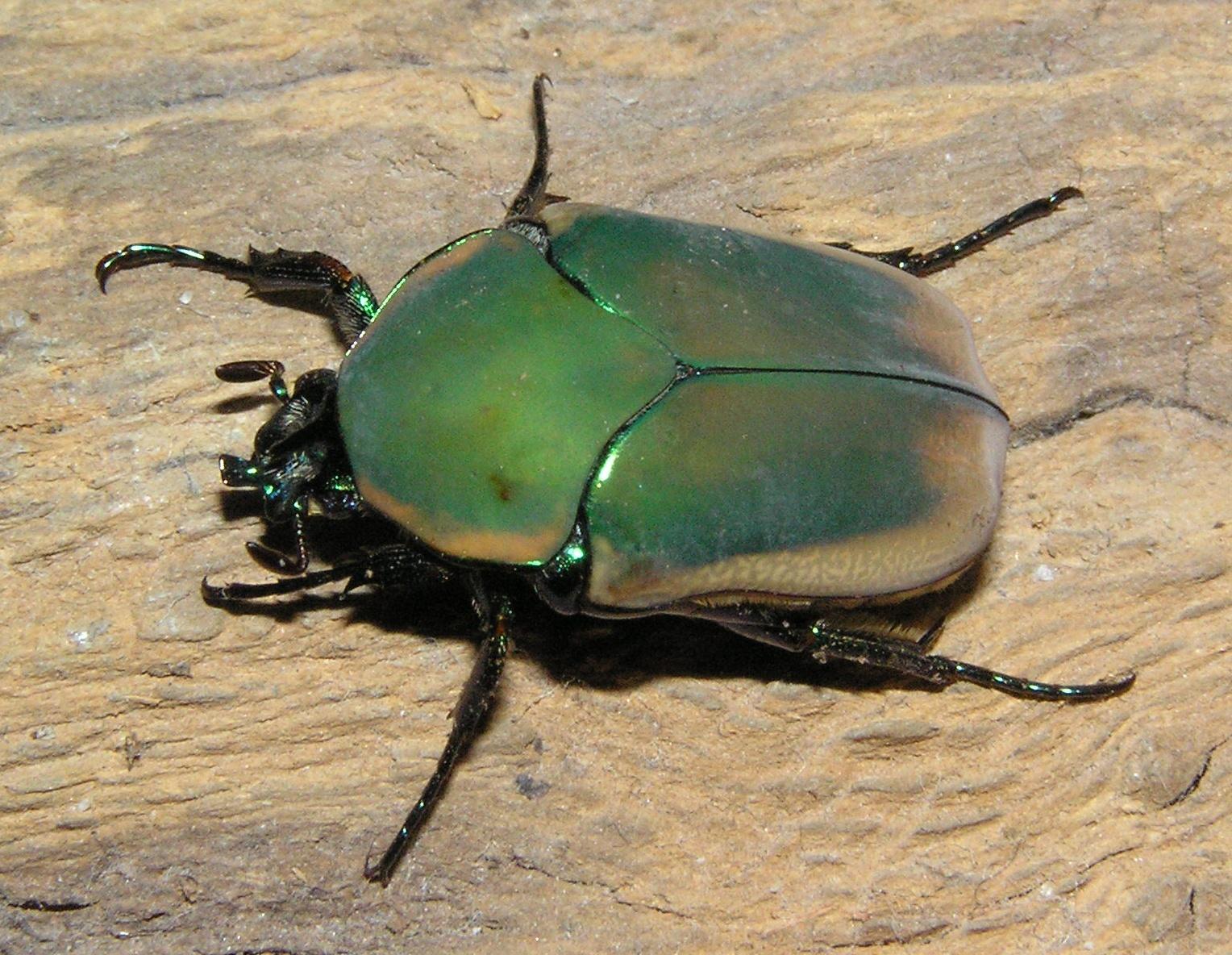
The Figeater Beetle, scientifically known as Cotinis mutabilis, is one of the largest beetle species found in the southern regions of North America.
With a size that can reach up to 1.2 inches, these beetles have become a common sight in gardens and around residential areas.
Their diet consists of organic materials and fruit, which often leads them to apple or peach trees in rural landscapes.
This species is also frequently observed in mulch across the southern states of the U.S.
Most of the beetle’s body is green, featuring a green elytron adorned with yellow to golden stripes on the sides, a coloration that bears a resemblance to Green June Beetles.
Interestingly, their green hue might be influenced by their dietary choices. For instance, while they do consume cacti, they prefer those found in damp areas.
Unlike many other green insects, Figeater Beetles thrive in moist environments, which are the typical habitats they occupy in the Southwest.
13. Green Immigrant Leaf Weevil
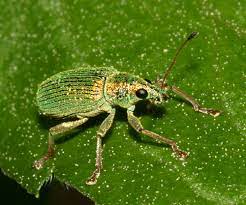
The Green Immigrant Leaf Weevil, known scientifically as Polydrusus formosus, is a mostly green insect known for its penchant for feeding on plants.
The bug displays bright green elytra, which have a striking emerald undertone.
Striated markings are visible across its elytra, which also exhibit a black central dorsal section.
Touches of golden yellow can also be spotted along its body.
Notably, the legs and antennae of these weevils are also predominantly green.
In terms of size, this species is relatively small compared to other green weevils, growing up to a maximum length of 0.2 inches.
However, its presence in a garden could be a cause for concern, as this species is a known pest of fruits. It is known to feed on apples, strawberries, and other garden berries.
14. Common Green Bottle Fly
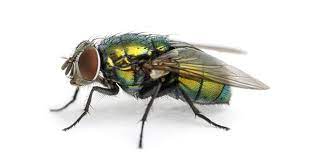
The Common Green Bottle Fly, or Lucilia sericata, can be found in both humid and dry areas across the United States.
This type of fly is distinctive for its unique metallic green body color.
Flies from this genus are especially prevalent during the spring and summer months, when their mating activity peaks.
Female flies lay their eggs in carrion and can also deposit them on living livestock. The practice of moving from dead animals to live ones can facilitate the spread of disease-causing pathogens.
Sheep, in particular, are susceptible to infestations from these flies.
The female fly might opt to lay eggs directly on a sheep’s skin, significantly increasing the chances of causing diseases and skin infections like myiasis.
Alternatively, the flies may choose to lay their eggs within the sheep’s wool, which presents a slightly lesser risk of causing myiasis.
15. Green Stink Bug

Stink Bugs are notorious pests that often wreak havoc on crops and gardens.
The Green Stink Bug, characterized by its entirely green hue, is a prevalent species globally.
During summer, these bugs often swarm crops in large numbers, especially those of legumes like soy, eggplant, and beans.
Although Green Stink Bugs, scientifically known as Chinavia hilaris, also attack fruits such as peaches, apricots, and pears, they have a notable preference for legumes and are frequently observed on corn crops.
Their activity often results in diminished fruit yield due to the direct damage they cause. The fruits and leaves they feed on become unsellable or even perish since the bugs inject enzymes into them during feeding.
Interestingly, the nymphs of this species, while smaller, resemble the adults. However, unlike the green adults, the nymphs primarily exhibit a black color.
16. Pale Green Assassin Bug
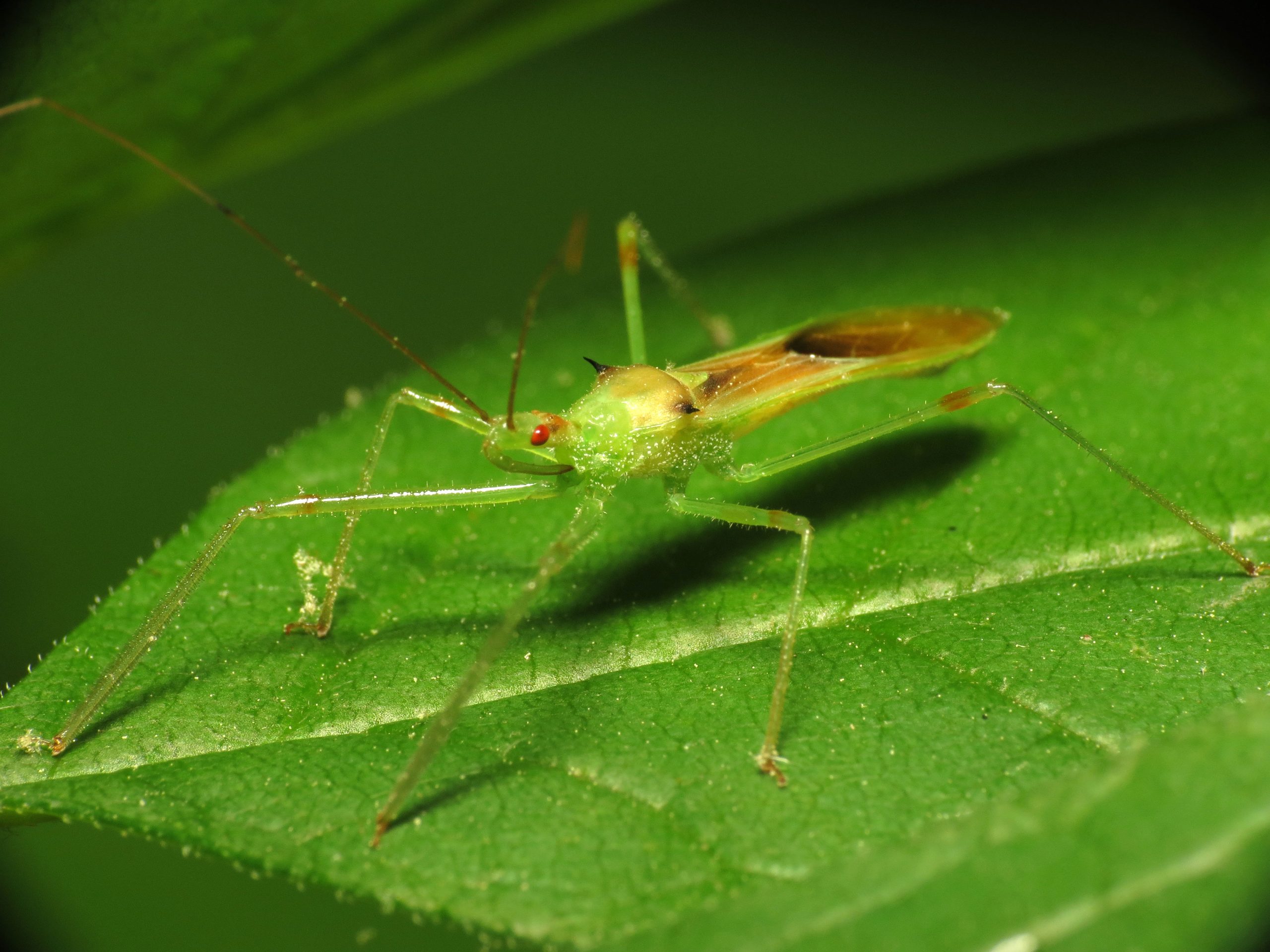
Pale Green Assassin Bugs (Zelus luridus) are among the prevalent green predators that maintain their green color throughout all their life stages.
From nymph to adulthood, this bug remains mostly green. The adults exhibit additional yellow and brown markings on their wings.
Their green hue provides an advantageous camouflage, aiding them greatly in their hunting tactics.
Known for their effective ambush strategies, these bugs usually stay stationary, patiently waiting for their prey to come within striking range.
Though Pale Green Assassin Bugs have the ability to pursue their prey actively, they typically remain immobile due to their incredible ability to blend into leafy surroundings, rendering them virtually invisible to many insects.
17. Broken-Backed Bug
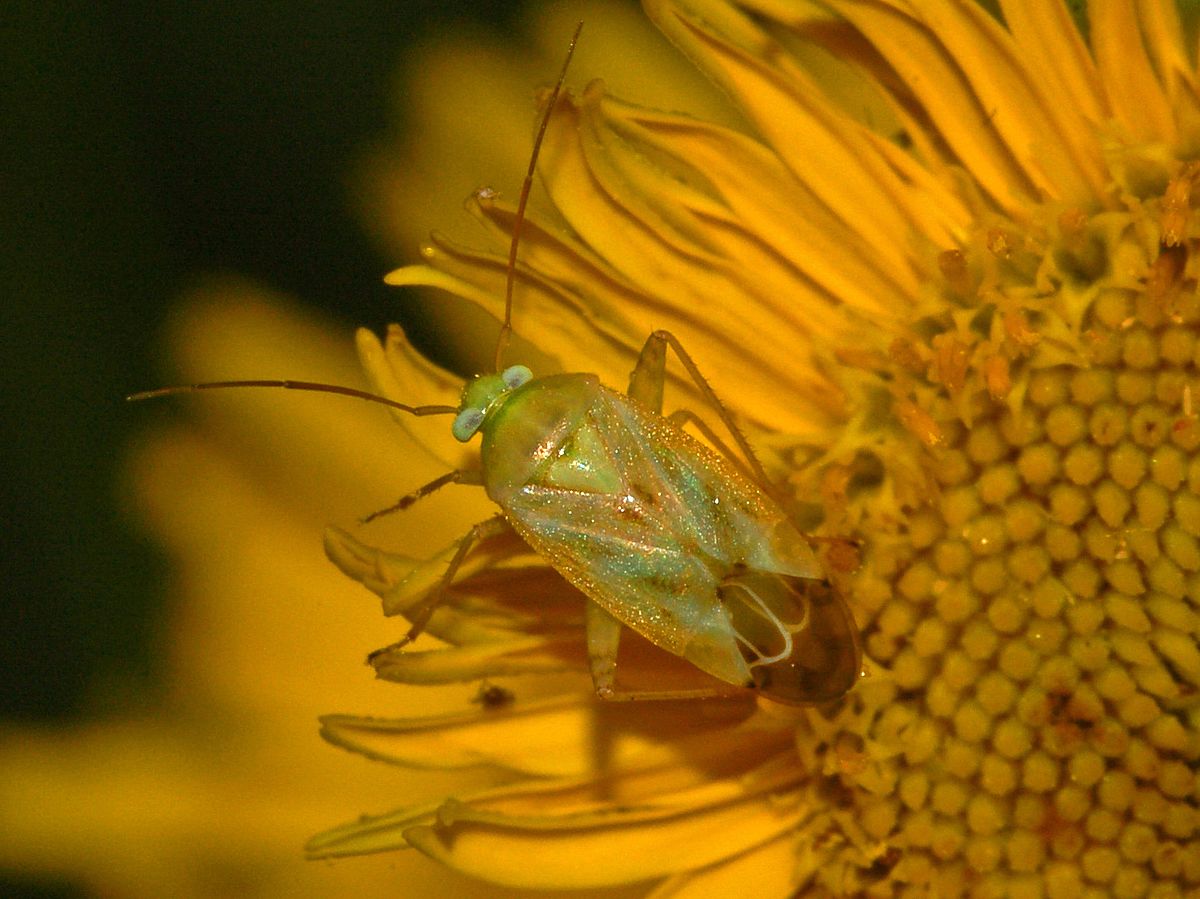
The Broken-backed Bug (Taylorilygus apicalis) is distinguished by its light green hue.
Compared to other green species, the Broken-backed Bug exhibits a pale green coloration, which can sometimes appear semi-translucent.
There are also brown variants of this bug, but these are considerably less common than their green counterparts.
These bugs are particularly fond of asters, which serve as their primary food source.
In the absence of asters, these green insects tend to resort to other host plants, particularly willow and other species found in water-rich environments.
18. Rice Leaf Bug
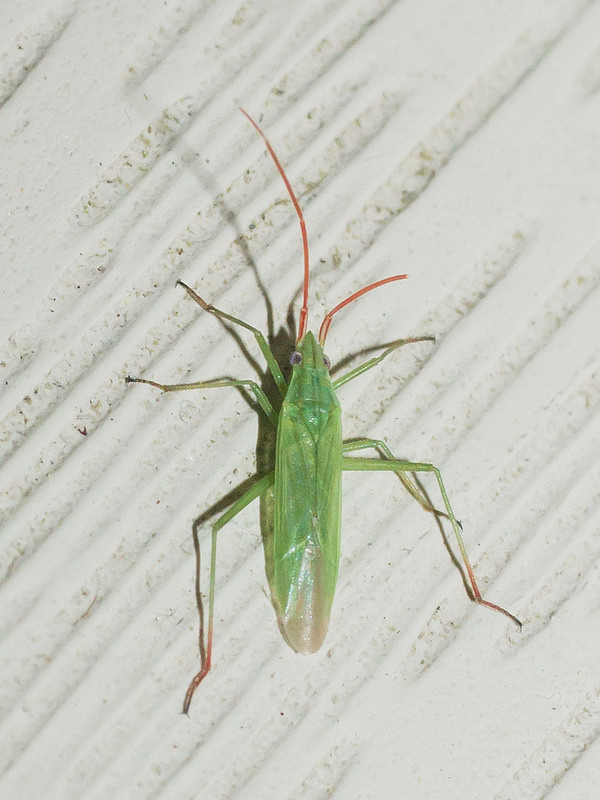
The Rice Leaf Bug (Trigonotylus caelestialium) is a prominent green pest, notorious in rice cultivation.
This insect displays a slender, stick-like body enveloped in a vibrant green hue, contrasted by light brown legs and antennae.
It is primarily associated with forage crops, typically grown for livestock feed.
However, they have been known to infiltrate rice fields adjacent to these forage crops. Initially, rice wasn’t their primary choice of food, but over time, rice grains have become a dietary mainstay, even influencing the bug’s name.
Though originally from Asia, this species has also firmly established its presence in North America.
Indications of their invasion often present as spots on the plant’s kernels. As for dealing with these pests, emphasis is placed on preventative strategies.
19. Northern Flatid Planthopper
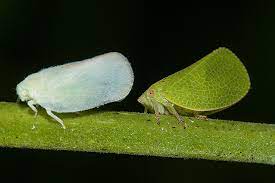
The male Northern Flatid Planthopper (Flatormenis proxima) is distinguished by its vivid green hue, showcasing various shades of green.
Its primary color is a striking bright green, accented by dark green veins.
The insect’s body and slender legs are also characterized by the same bright green shade.
As a species commonly found feeding on leaves, this particular planthopper possesses distinct wing shapes. It has elongated wings that closely adhere to its body, making it resemble a leaf.
This overall green appearance contributes to its effective camouflage abilities.
20. Green Cone-Headed Planthopper

The Green Cone-headed Planthopper (Acanalonia conica) stands out for its remarkable resemblance to a leaf, characterized by its dark green wings, body, and head.
The light green veins running across its tent-like wings blend seamlessly with the foliage of host plants when viewed from certain angles.
A distinctive feature of this species is its ability to exude a wax-like substance, a trait also observed in the Northern Flatid Planthopper.
This waxy coating is more prevalent in the nymphs of the species, serving as a deterrent to predators.
While they possess wings, these creatures exhibit a strong preference for hopping, capable of covering distances exceeding 10 inches.
Inhabiting the Southeastern United States, these planthoppers feed primarily on leaves, posing little threat to the overall health of host plants.
However, potential damage may occur if their sticky excrement, known as honeydew, accumulates in large quantities, promoting the growth of mold that can ultimately prove lethal to the host plant.
21. Versute Sharpshooter

The Versute Sharpshooter (Graphocephala versuta) is characterized by its foundational green hue, though it is not entirely green.
This creature showcases a rich mix of colors, with dark green as its base color, adorned with stripes of blue and tan or brown across its wings. It also has contrasting black elements enhancing its vibrant appearance.
The species are prolific breeders, producing several broods annually.
The Sharpshooters employ their green coloration and small stature to their advantage when feasting on leaves, making it difficult for predators to detect them. Besides, they have a knack for seeking shelter on the underside of leaves.
Their populations are concentrated heavily in Costa Rica, although a significant number can also be found in the United States.
22. Potato Leafhopper

The Potato Leafhopper (Empoasca fabae) is a widespread green pest insect, known for its affinity for attacking a variety of plants and legumes, despite its relatively small size, rarely exceeding 3mm in length.
As the name suggests, potato plants are particularly vulnerable to these insects. Moreover, clover fields are often targeted by this species.
These little creatures are capable of consuming an entire potato plant. The damage they inflict varies with their age, as younger bugs typically feed only on the softer potato leaves, finding it hard to consume the tougher stems.
Their vibrant green body and the distinctive spots on their wings, typically six in number, make them easily identifiable on crops. Additionally, they exhibit faint yellow stripes just behind their heads.
These bugs pose a significant challenge to farmers due to their impressive migratory capabilities. Capable of sustaining flight for days to locate their preferred crop, their movements mostly go undetected as they typically migrate under the cover of darkness.
23. Torpedo Bug

The Torpedo Bug (Siphanta acuta) is an expanding leafhopper species displaying vibrant green coloration.
Originally native to Australia, it has now spread to various other continents, including North America.
Unlike other green bugs, the Torpedo Bug maintains its green hue throughout all stages of its life. Both as nymphs and adults, they exhibit a consistent and uniform green coloring.
The young Torpedo Bug nymphs possess a faint green coloration, while the adult bugs experience a slight darkening of their green shade. This green hue covers their head, body, and distinctive tent-shaped wings.
In terms of size, Torpedo Bugs rank among the larger green leafhoppers outside of Australia. Some individuals can reach lengths of approximately 10mm.
Feeding on leaves, these bugs generally do not cause severe damage to the host plants. Additionally, the small or nymph Torpedo Bugs often bear a protective coating of waxy substance, which serves as a defense against potential predators.
24. Green Lynx Spider
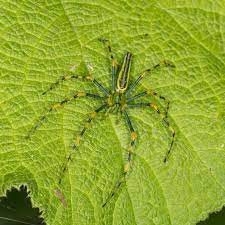
Among the notable large green bugs are green spiders, with the Green Lynx Spider (Peucetia viridans) being a prominent representative. Despite its appearance, this species poses no threat to humans.
The spider relies on its green coloring to effectively capture a diverse range of prey.
The Green Lynx Spider stands out with its body exhibiting a dark green hue, while its legs display a striking range of bright green to white tones.
Distinctive large white eyes further contribute to its unique appearance.
Green Lynx Spiders can be found in various regions of the United States.
This species often maintains a constant presence in crop fields, where it can serve as a biological control agent by preying on harmful species. For instance, the Green Lynx Spider is known to target moths like the Cotton Leafworm Moth.
However, it is worth noting that this spider’s diet is not solely composed of detrimental species. It may also consume beneficial insects that play important roles in the ecosystem.
25. Red-Spotted Orbweaver

The Red-spotted Orbweaver (Araneus cingulatus) is another common green spider found in North America.
This species is often difficult to spot due to its preference for woodland habitats. It typically resides in trees, where it constructs its intricate spider web.
The predominantly green body coloration of the Red-spotted Orbweaver allows it to blend seamlessly with its surroundings, making it easily overlooked by passing insects.
Both its body and legs exhibit a consistent green hue, creating a uniform appearance.
Notably, these spiders possess a bulbous body shape. They also feature distinct yellow dorsal coloring, accompanied by tiny red dots on their yellow patches.
26. Potato Aphid
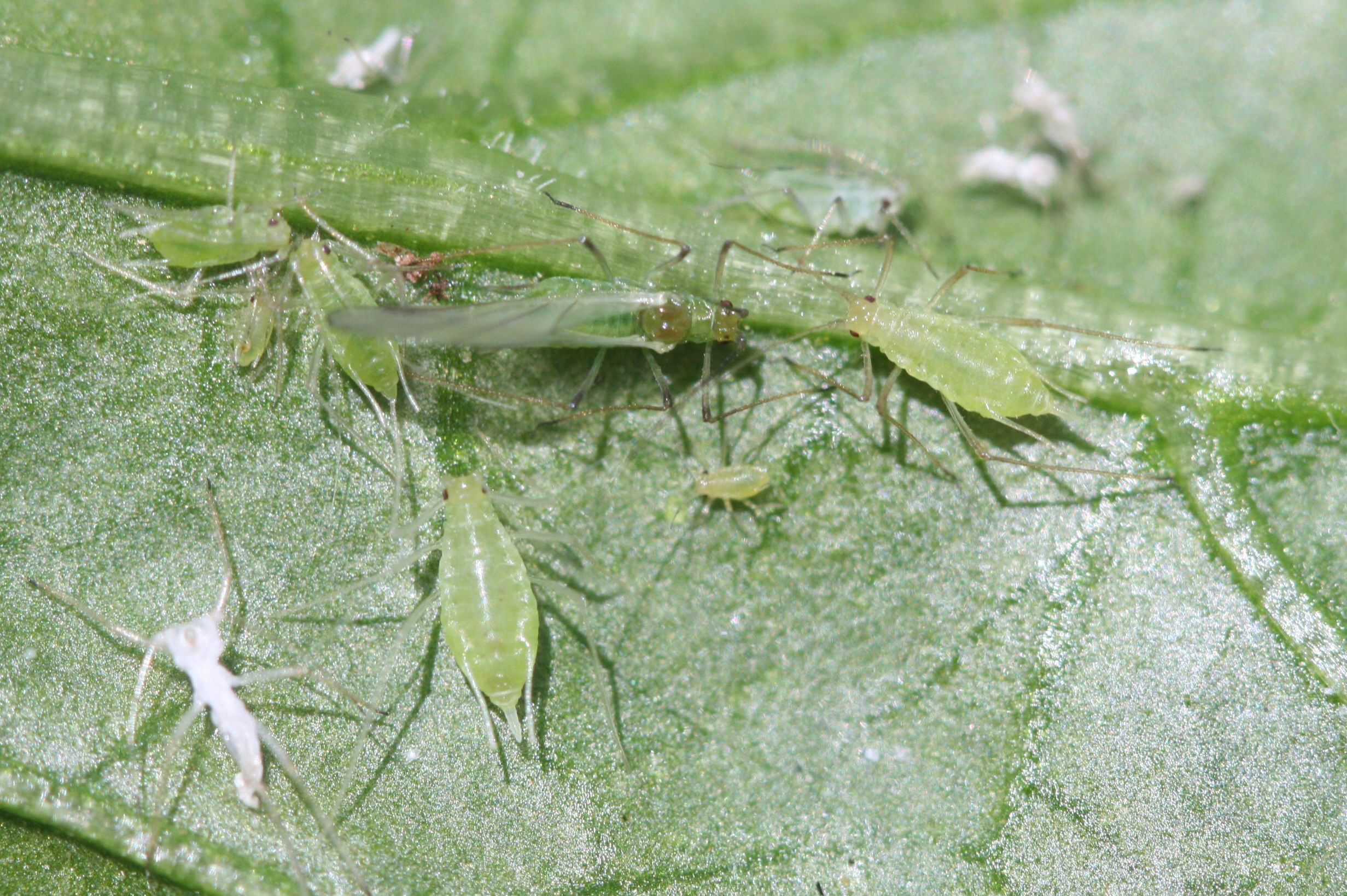
The Potato Aphid (Macrosiphum euphorbiae) is a particularly destructive pest that poses a significant threat to various crops.
Distinguished by its green body color, this species of winged aphid also possesses large, transparent wings that exceed the length of its body.
The presence of Potato Aphids is an alarming indication, as they are notorious pests of potato plants. Moreover, they have a tendency to migrate and infest other fruit trees, such as peaches.
These aphids primarily inhabit crops but can also infiltrate greenhouse environments.
Their feeding habits are highly detrimental, as they have the ability to consume plant tissue and extract sap directly from their host plants. This feeding behavior can cause substantial damage to a wide range of plant species.
27. California Timema
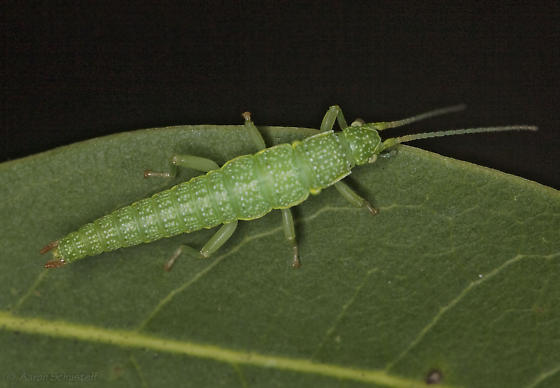
The California Timema (Timema californicum) stands out with its distinctive and unconventional shape. This species possesses a tubular body resembling that of a stick, allowing it to blend seamlessly with its environment.
The dark green hue of its body is complemented by lighter green legs, as well as bright green to white long antennae.
To add contrast to its overall green appearance, the California Timema showcases short brown cerci.
Notably, this species also exhibits small yellow dots on its dorsal side, along with long lateral yellow stripes that run along its body.
28. Praying Mantis
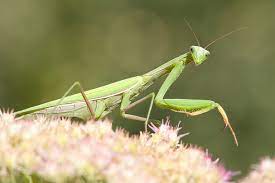
The world is home to over 2,000 different species of Praying Mantises, with 21 of them residing in North America.
Green coloring is a common characteristic among many Praying Mantises, although brown shades are also prevalent.
With their camouflaging green color, these insects effectively utilize their robust raptorial legs for capturing prey.
Praying Mantises are large bugs recognized for their predatory behavior and their role as insectivores.
Capitalizing on their adept camouflage, Praying Mantises patiently await the arrival of unsuspecting insects within their striking range, seizing them with precision.
Among the diverse species, the Chinese Mantis claims the title of the largest Praying Mantis in the world, measuring up to 5 inches in length and boasting a predominantly green body.
This species can also be found in parts of the United States, such as Missouri, where its green coloration aids in hunting a variety of insects and spiders.
29. Green Mantidflies
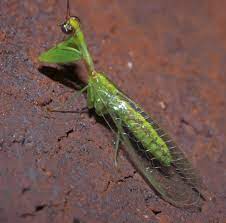
The Green Mantidflies (Zeugomantispa minuta) are distant relatives of the Praying Mantis, possessing similar characteristics and behaviors.
These flying insects predominantly display a green coloration, reminiscent of the Praying Mantis. Additionally, they have long, transparent wings.
Notably, right beneath their transparent wings, one can observe distinctive purple to brown markings.
Both the forewings and hindwings of the Green Mantidflies are transparent, showcasing contrasting black veins.
While native to certain regions in Central America, this species has also expanded its presence to North America and parts of South America.
30. Grasshoppers
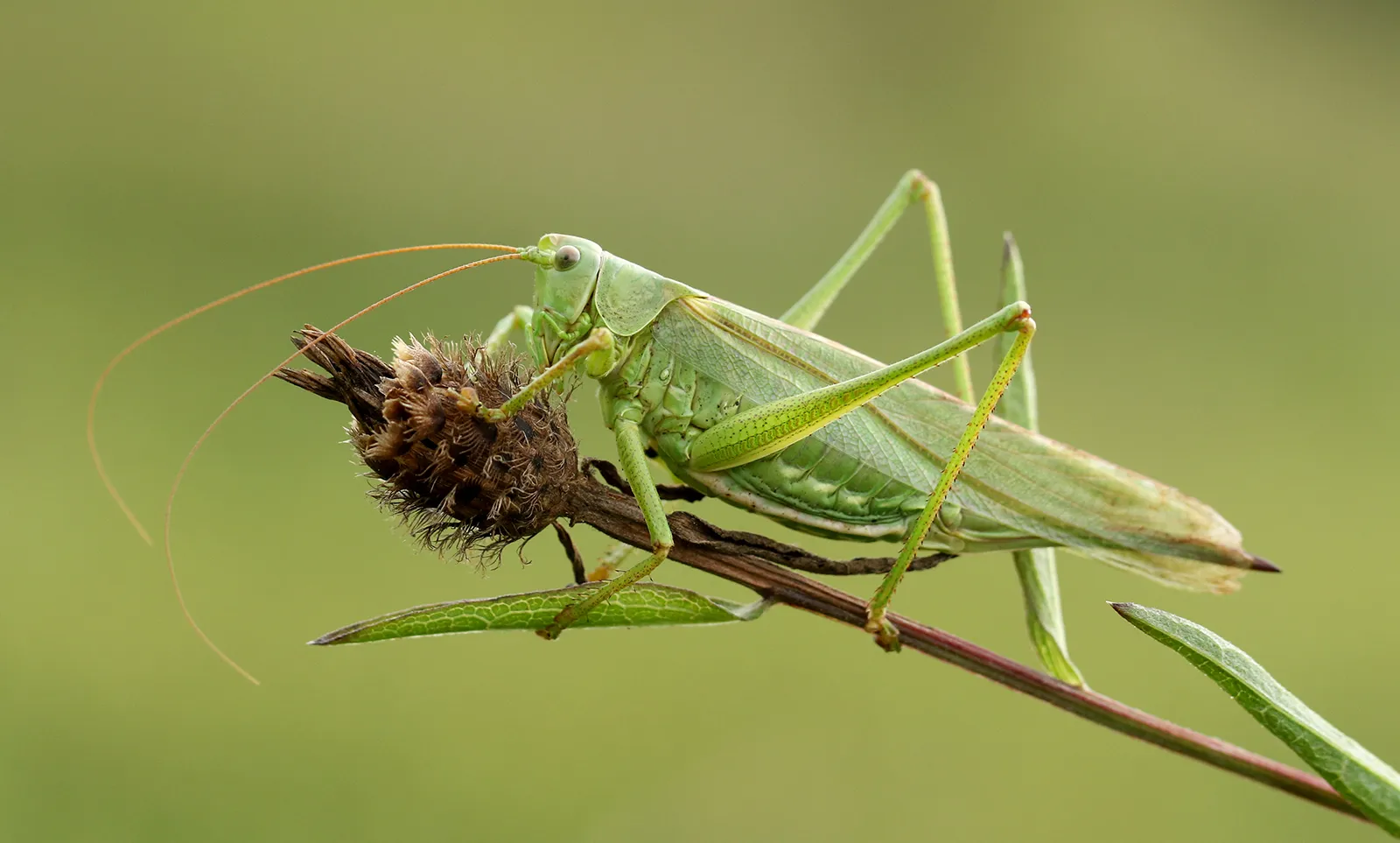
True Crickets, belonging to the Ensifera order, encompass a prevalent group of predominantly green grasshoppers.
These grasshoppers possess elongated green bodies and long green wings, equipped with specialized structures called scrapers. These scrapers enable them to produce the distinctive sounds associated with grasshoppers.
In addition to their green coloration, these grasshoppers, along with other green species, are renowned for their remarkable jumping abilities. By propelling their hind legs forcefully into the ground, they can launch themselves considerable distances.
31. Katydids
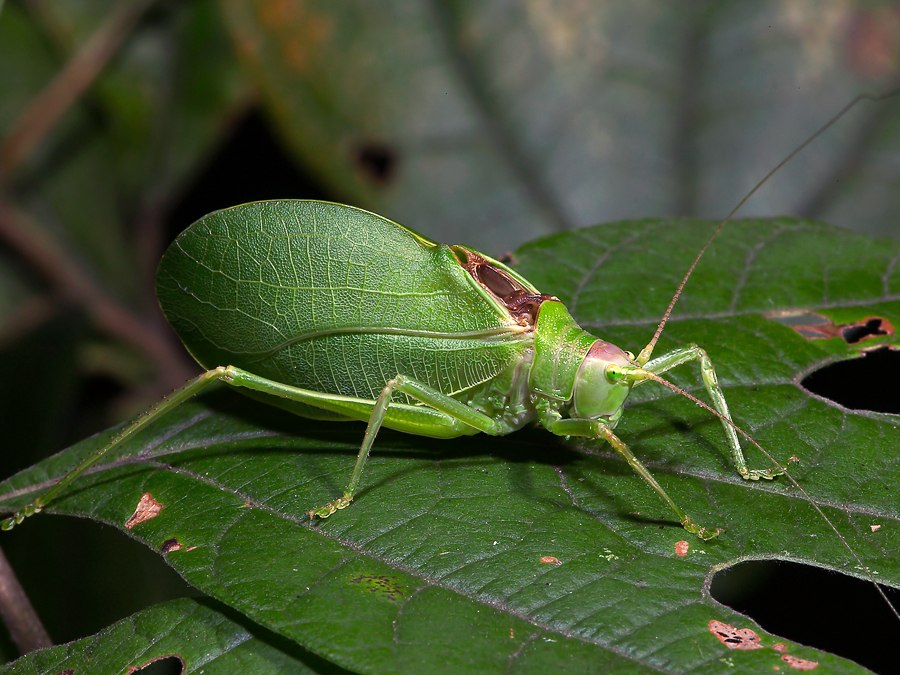
Katydids are a globally distributed group of insects, encompassing thousands of species, with some exhibiting an entirely green coloration.
The predominantly green hue of these bugs serves as an effective camouflage mechanism, enabling them to blend seamlessly with their surroundings, often resembling leaves to evade the attention of potential predators.
Among the various subspecies, False Leaf Katydids stand out with their dark green coloration, mimicking the shape and appearance of actual leaves.
In addition to their camouflaging abilities, these katydids are known for their remarkable talent of producing bird-like chirping sounds, further adding to their intriguing characteristics.
